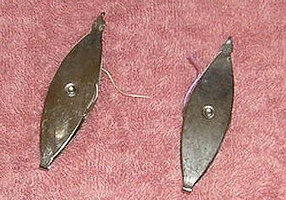
Located at the Corner of Combs
and West Main Street
Collinsville, IL 62234
Tatting
Art and Status Symbol of the 19th Century

Sandee Kane talks about the art of tatting, a form of lace-making, at the First Annual Christmas Gathering at the D.D. Collins House.
Sandee not only demonstrated how tatting is done, she also shared her collection of shuttles, the instrument used to create the knots in the thread to create the lacy edges.
In addition, Sandee also shared a variety of examples of tatted patterns.
tat /tat/ verb ~ make (a decorative mat or edging) by tying knots in thread and using a small shuttle to form lace.
DID YOU KNOW? . . .
Tatting with a shuttle is the earliest method of creating tatted lace. A tatting shuttle facilitates tatting by holding a length of wound thread and guiding it through loops to make the requisite knots. Historically, it was a metal or ivory pointed-oval shape less than 3 inches (76 mm) long, but shuttles come in a variety of shapes and materials. Shuttles often have a point or hook on one end to aid in the construction of the lace. Antique shuttles and unique shuttles have become sought after by collectors — even those who do not tat.
To make the lace, the tatter wraps the thread around one hand and manipulates the shuttle with the other hand. No tools other than the thread, the hands and the shuttle are used, though a crochet hook may be necessary if the shuttle does not have a point or hook.

Vintage tatting shuttles from the 19th and early 20th century.

HISTORY . . .

Tatting may have developed from netting and decorative rope work as sailors and fishermen would put together motifs for girlfriends and wives at home. Decorative rope work employed on ships includes techniques (esp. coxcombing) that show striking similarity with tatting. A good description of this can be found in Knots, Splices and Fancywork.

Some believe tatting originated over 200 years ago, often citing shuttles seen in 18th-century paintings of women such as Charlotte of Mecklenburg-Strelitz, Mme. Marie Adélaïde (daughter of Louis XV of France), and Anne, Countess of Albemarle. A close inspection of those paintings, however, shows that the shuttles in question are too large to be tatting shuttles, and that they are actually knotting shuttles. There is no documentation of or example of tatted lace that dates prior to 1800. All available evidence shows that tatting originated in the early 19th century.
Excerpt from: wikipedia, click for more from this article.
ROYALTY . . .
Tatting is an ancient form of lace making, traditionally frequented by upper class ladies due to the enormous time involved. Notably, Queen Victoria of England and Archduchess Maria Theresa of Austria enjoyed tatting.
Tatting involves wrapping thread around one or two shuttles and using the shuttles to guide the thread into patterns of knots to create rings and chains in delicate designs.
Projects can include doilies, earrings, necklaces, ornaments, bookmarks, baby caps and booties, wedding veils, as well as edgings on handkerchiefs, purses, garments, placemats, note cards, and much, much more.
Excerpt from: Tatted Treasures, click for more from this website.
19th CENTURY TATTING . . .
Lace was in great demand in the 19th century. Everyone wanted some, but the classic laces were extremely expensive, out of the reach of most people. This encouraged creativity, which was helped too by the newly available tougher mercerized threads produced from about 1840. Inventive needleworkers found ways of making lace that were relatively inexpensive and also much quicker to produce than the traditional forms. One of these was tatting.
The first tatting consisted of rings only - usually worked in a length of slightly spaced rings. The rings would be arranged and laboriously stitched together in motifs as you see below. Often needle-lace fillings were worked in too. The square doyley pictured below (11.5" or 29cm square) was tatted in this way, which probably dates it to the 1840's. (Or it could be later, but done by an old-fashioned tatter who hadn't caught up with the latest methods.)
AND THE RESEARCH CONTINUES . . .
This parasol probably dates from the 1850s, when they became very fashionable and as much a status symbol as a protection from the sun. There is a pattern for a parasol cover in Mlle Riego's book "The Lace Tatting Book" (1866) - see Book List.
It is always hard to trace the history of domestic arts and crafts. So much was passed on from person to person by example and by word of mouth. But the 19th century saw an increasing number of publications on all kinds of subjects, including tatting. So it is that we know that tatting was around in 1843 because a booklet on the basics of tatting was published then.
Excerpt from: Ring of Tatters, click to read more.
So much to learn about the beauty of the past.
Phone: Call Lavadna at 618.420.0288
Mail: c/o 104 Irene Dr., Collinsville, IL 62234
Email: artloft@charter.net


